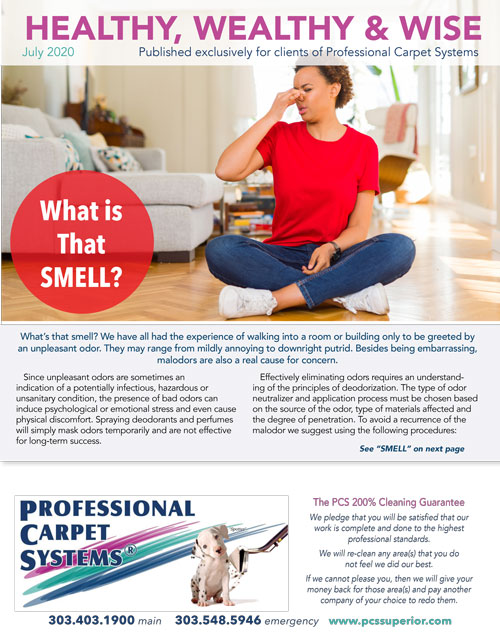Here’s our July 2020 client newsletter.
Click here to see the full newsletter
What is that Smell?
What’s that smell? We have all had the experience of walking into a room or building only to be greeted by an unpleasant odor. They may range from mildly annoying to downright putrid. Besides being embarrassing, malodors are also a real cause for concern.
Since unpleasant odors are sometimes an indication of a potentially infectious, hazardous or unsanitary condition, the presence of bad odors can induce psychological or emotional stress and even cause physical discomfort. Spraying deodorants and perfumes will simply mask odors temporarily and are not effective for long-term success.
Effectively eliminating odors requires an understanding of the principles of deodorization. The type of odor neutralizer and application process must be chosen based on the source of the odor, type of materials affected and the degree of penetration. To avoid a recurrence of the malodor we suggest using the following procedures:
Step 1: Find and remove the source. Odor is an effect. Since every effect has a cause, our first challenge is to find and remove the cause. If the odor comes from a dead animal, you must find the carcass and remove it. If the odor is from a pet accident, you must first locate the deposit and remove it from the carpet and other surfaces before treating the offending odor. The same applies to odors from smoke, cooking, mold, mildew, etc.
Step 2: Clean the affected area to remove any remaining odor-causing residue. Actually, cleaning is just a continuation of source removal. Start cleaning in the source area and work outward until all residues are removed. Residues can be sticky or oily residues, crystallized materials or dust and soot. The type of residue and the material you are cleaning determines the cleaning method. For instance, removing soot from a concrete block wall requires a different cleaning method than removing the same soot from silk drapes. Depending on the odor, source removal and meticulous cleaning may be all that is required. If not, move on to the next step.
Step 3: Recreate the conditions of penetration. This is where specialized equipment is often required. For instance, if the odor is from smoke, it may have penetrated into wood, fabrics, drywall and may other porous and semi-porous materials. Any deodorizing products must penetrate the materials in the same manner in order to neutralize the odors.
If odors have penetrated into areas that are inaccessible, it may be necessary to use thermal or Ultra Low Volume fogging equipment, oxidation, ozone or dry vapor exchange equipment. Generally, odors caused by liquids such as urine or spoiled milk that have saturated porous materials must be saturated with a suitable odor counter-agent. In most cases, properly applying steps 1 through 3 will achieve the desired results. If there is still an odor proceed to step 4.
Step 4: Seal the affected material. In some cases, odors may have penetrated into materials to the degree that it is impossible or impractical to remove them completely. In these cases it is necessary to apply a topical sealant to encapsulate the odor-causing molecules and prevent them from evaporating into the air. If the molecules can’t reach your nose, you won’t be able to smell them. The type of sealer you choose depends on the type of material, the nature of the odor source and the degree of penetration into the material.
Call Professional Carpet Systems for more tips, help or to schedule your next appointment.

